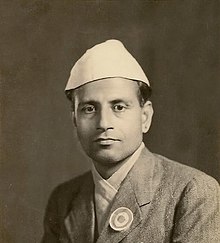| Matrika Prasad Koirala मातृका प्रसाद कोइराला | |
|---|---|
 | |
| 18th Prime Minister of Nepal | |
| In office 16 November 1951 – 14 August 1952 | |
| Monarch | Tribhuvan |
| Preceded by | Mohan Shumsher Jung Bahadur Rana |
| Succeeded by | Direct Rule by King Tribhuvan |
| In office 15 June 1953 – 11 April 1955 | |
| Monarchs | Tribhuvan Mahendra |
| Preceded by | Direct Rule by King Tribhuvan |
| Succeeded by | Interim Served by Surya Bahadur Thapa |
| Nepali Ambassador to the United States | |
| In office 13 July 1961 – 3 August 1964 | |
| Preceded by | Rishikesh Shah |
| Succeeded by | Padma Bahadur Khatri |
| 1st President of the Nepali Congress | |
| In office 12 April 1950 – 26 May 1952 | |
| Preceded by | Party established |
| Succeeded by | B. P. Koirala |
| Personal details | |
| Born | (1912-01-01)1 January 1912 Varanasi, British India |
| Died | 11 September 1997(1997-09-11) (aged 85) Biratnagar, Nepal |
| Parent(s) | Krishna Prasad Koirala Mohan Kumari Koirala |
| Relatives | See Koirala family |
Matrika Prasad Koirala (Nepali: मातृका प्रसाद कोइराला Listen; 1 January 1912 – 11 September 1997) was the Prime Minister of Nepal for two separate terms from 16 November 1951 to 14 August 1952 and again from 15 June 1953 to 11 April 1955.
Personal life
Koirala was born to Krishna Prasad Koirala and his first wife Mohan Kumari Koirala in 1912 in Varanasi, British India. His brothers were Bishweshwar Prasad Koirala and Girija Prasad Koirala, who also served as prime ministers of Nepal, and politician and journalist Tarini Prasad Koirala.
Political career
Matrika Prasad Koirala was politically active in India where his father Krishna Prasad Koirala was living in exile. He stayed in the house of Dr. Rajendra Prasad, the first President of free India and was influenced by the Indian independence struggle. He participated in the Indian independence movement with his brother BP Koirala. Both brothers were arrested and imprisoned by the British Raj for three months in 1930. He was made President of the Congress Party in Bihar by Dr Rajendra Prasad for a while as all the other senior Indian leaders were jailed during the Quit India Movement.
He later joined the Nepali National Congress led by Tanka Prasad Acharya and fought against the Rana regime. Koirala became the first President of Nepali Congress, when it was formed as a result of the merger of Nepali National Congress and Nepal Democratic Congress in April 1950. Koirala became the first commoner Prime Minister of Nepal after Rana rule ended.
In 1952, he was expelled from the Nepali Congress for "violating the party principles and acting against the Constitution of 1951".
Koirala also served as Nepal's permanent representative to the UN and ambassador to the United States from 1961 to 1964.
References
- "Nepal: Former prime minister dies". Archived from the original on 3 March 2016. Retrieved 7 May 2009.
- worldstatesmen.org
- Uhash, Rupesh. "Bisheshwor Prasad Koirala". Spiny Babbler. Archived from the original on 11 November 2013. Retrieved 27 December 2013.
- Nepali Congress:An introduction Archived 8 February 2011 at the Wayback Machine
- "Nepali Congress". Important Landmarks. Nepali Congress. Retrieved 26 December 2013.
- "Frist Lions Club in Nepal". Lions Clubs International District 325 A1 Nepal. Lions Club. Archived from the original on 10 May 2013. Retrieved 27 December 2013. "He was nominated as a permanent representative of United Nations Organization and was appointed as Nepal’s Ambassador to United States of America from 1961-64"
- 1912 births
- 1997 deaths
- 20th-century prime ministers of Nepal
- Finance ministers of Nepal
- Koirala family
- Nepali Congress politicians from Koshi Province
- People from Biratnagar
- Politicians from Varanasi
- Members of the National Assembly (Nepal)
- Ministers of foreign affairs of Nepal
- Nepalese expatriates in India
- Nepalese exiles
